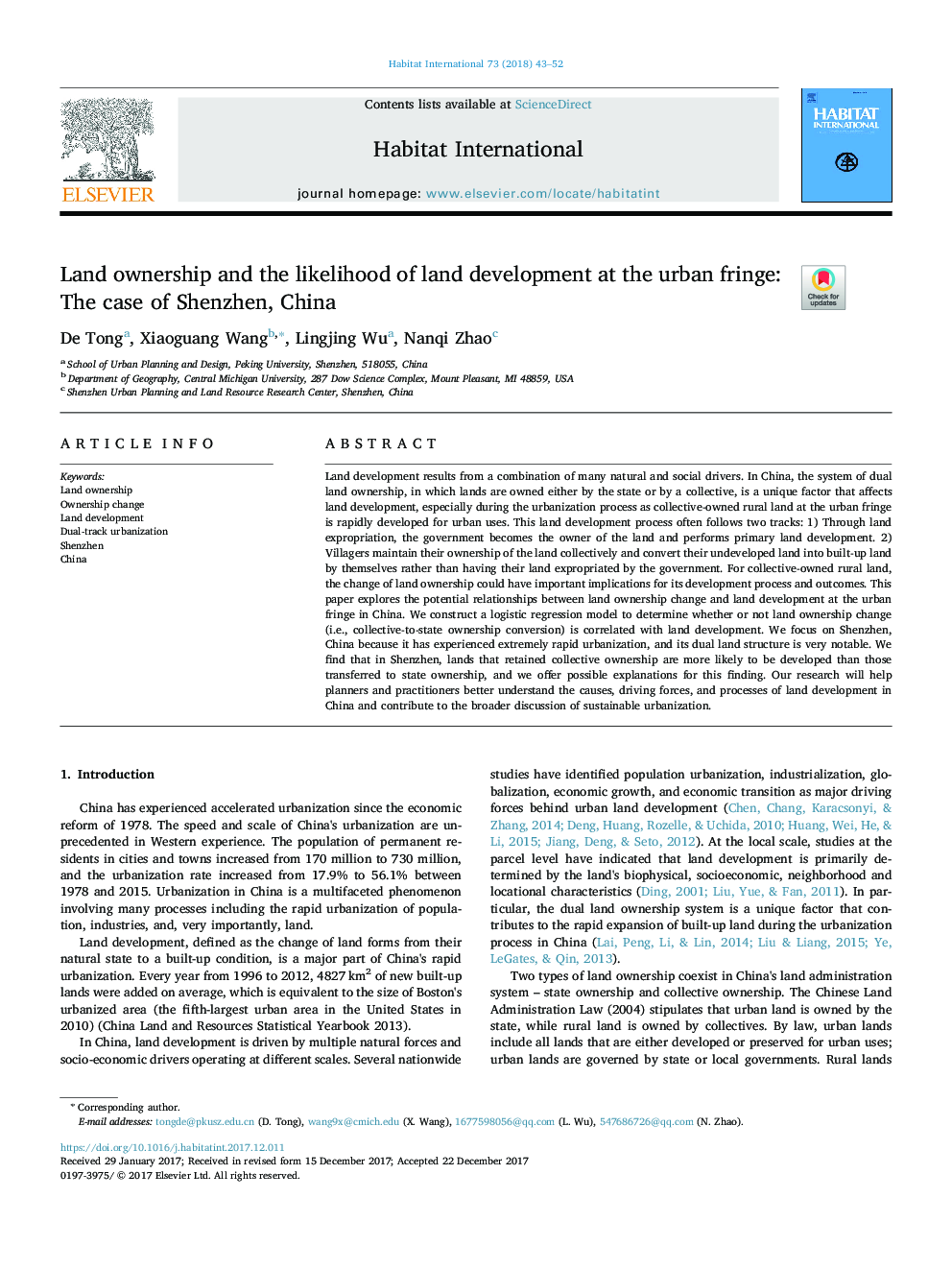| کد مقاله | کد نشریه | سال انتشار | مقاله انگلیسی | نسخه تمام متن |
|---|---|---|---|---|
| 7455164 | 1484471 | 2018 | 10 صفحه PDF | دانلود رایگان |
عنوان انگلیسی مقاله ISI
Land ownership and the likelihood of land development at the urban fringe: The case of Shenzhen, China
ترجمه فارسی عنوان
مالکیت زمین و احتمال توسعه زمین در حاشیه شهر: مورد شنزن، چین
دانلود مقاله + سفارش ترجمه
دانلود مقاله ISI انگلیسی
رایگان برای ایرانیان
کلمات کلیدی
مالکیت زمین، تغییر مالکیت، توسعه زمین، شهرسازی دوگانه، شنژن، چین،
ترجمه چکیده
توسعه زمین از ترکیبی از بسیاری از رانندگان طبیعی و اجتماعی است. در چین، سیستم مالکیت دوگانه زمین، که در آن اراضی متعلق به دولت یا جمعی است، یک عامل منحصر به فرد است که بر توسعه زمین، به ویژه در طول روند شهرسازی، به عنوان زمین های روستایی جمعی در ناحیه شهری به سرعت در حال تغییر است برای استفاده شهری توسعه یافته است. این فرایند توسعه زمین اغلب به دو مسیر زیر پی می برد: 1) از طریق سلب مالکیت زمین، دولت مالک زمین می شود و زمین های اولیه را توسعه می دهد. 2) روستائیان مالکیت زمین را به صورت جمعی حفظ می کنند و زمین های توسعه نیافته خود را به جای زمین های خود از دست می دهند. برای زمین های روستایی جمعی، تغییر مالکیت زمین می تواند پیامدهای مهمی برای فرایند توسعه و نتایج آن داشته باشد. این مقاله به بررسی روابط بالقوه تغییر مالکیت زمین و توسعه زمین در حاشیه شهری در چین می پردازد. ما یک مدل رگرسیون لجستیک برای تعیین اینکه آیا تغییر مالکیت زمین (یعنی تبدیل مالکیت جمعی به دولت)، با توسعه زمین ارتباط دارد یا خیر. ما بر شنژن، چین متمرکز هستیم زیرا شهرنشینی بسیار سریع را تجربه کرده و ساختار دوجداره آن بسیار قابل توجه است. ما دریافتیم که در شنژن، زمین هایی که مالکیت جمعی را حفظ می کنند، بیشتر از آنچه که به مالکیت دولتی منتقل می شوند توسعه می یابد، و ما پیشنهادات احتمالی برای این یافته ها را ارائه می دهیم. تحقیقات ما به برنامه ریزان و متخصصین کمک می کند تا به دلیل درک علل، نیروهای رانندگی و فرایندهای توسعه زمین در چین و بحث در مورد شهرنشینی پایدار کمک کنند.
موضوعات مرتبط
علوم انسانی و اجتماعی
علوم اجتماعی
توسعه
چکیده انگلیسی
Land development results from a combination of many natural and social drivers. In China, the system of dual land ownership, in which lands are owned either by the state or by a collective, is a unique factor that affects land development, especially during the urbanization process as collective-owned rural land at the urban fringe is rapidly developed for urban uses. This land development process often follows two tracks: 1) Through land expropriation, the government becomes the owner of the land and performs primary land development. 2) Villagers maintain their ownership of the land collectively and convert their undeveloped land into built-up land by themselves rather than having their land expropriated by the government. For collective-owned rural land, the change of land ownership could have important implications for its development process and outcomes. This paper explores the potential relationships between land ownership change and land development at the urban fringe in China. We construct a logistic regression model to determine whether or not land ownership change (i.e., collective-to-state ownership conversion) is correlated with land development. We focus on Shenzhen, China because it has experienced extremely rapid urbanization, and its dual land structure is very notable. We find that in Shenzhen, lands that retained collective ownership are more likely to be developed than those transferred to state ownership, and we offer possible explanations for this finding. Our research will help planners and practitioners better understand the causes, driving forces, and processes of land development in China and contribute to the broader discussion of sustainable urbanization.
ناشر
Database: Elsevier - ScienceDirect (ساینس دایرکت)
Journal: Habitat International - Volume 73, March 2018, Pages 43-52
Journal: Habitat International - Volume 73, March 2018, Pages 43-52
نویسندگان
De Tong, Xiaoguang Wang, Lingjing Wu, Nanqi Zhao,
